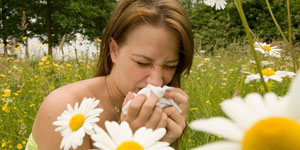
[Image source: iStockphoto]
Skip to: Main Navigation | Main Content
or try the A-Z Library
Allergic disease is on the rise in Australia. Although we don't know what causes allergies, or how to prevent them, most people learn to live with their condition.

In the developed world the number of people with allergic diseases continues to rise and Australia has one of the highest rates of allergies in the world, with around one in five Australians having at least one allergic disease.
There are a range of conditions that come under the banner of allergic diseases, including allergic rhinitis, (hayfever), asthma, eczema, food allergies and anaphylaxis.
Across the world the occurrence of allergic diseases has been rising since the second half of the 20th century and continues to do so.
An allergy is a type of inflammation that takes place when the body comes into contact with certain substances in the environment. These substances are called allergens (to denote that they cause an allergy) and they can be just about anything – a toxin from an insect sting, a food ingredient, an animal product (fur, dander) or a plant product (especially pollen).
These substances cause inflammation. But an allergy is different from the inflammation caused by germs like bacteria and viruses, or by heat, chemicals or physical injury.
In an allergic reaction the body's immune system releases chemicals such as histamine and immunoglobulin E (IgE) antibodies, which cause symptoms such as hives, swelling, redness and itching.
People often use the word 'allergy' to describe an intolerance or other bad reaction to a substance. But a true allergy is an inflammatory reaction that involves histamine and IgE. After exposure to an allergen, the response – the allergic reaction – is usually quick, within minutes (though it's possible for the inflammation to be chronic, and ongoing, for example in the bowel).
What symptoms and conditions the allergy causes depend on where the allergic reaction takes place in the body and what tissues are affected.
Allergic conditions include:
Anaphylaxis – is a serious, general, sudden, sometimes life-threatening collapse that can be caused by food, insect stings and medicines (commonly antibiotics). The allergic reaction can cause a catastrophic drop in blood pressure, or it can make the airways contract, making breathing difficult or sometimes both. When someone has anaphylaxis they need immediate treatment in the form of an injection of adrenaline using an adrenaline autoinjector (such as an EpiPen) and emergency medical treatment. While it's terrifying and potentially dangerous, deaths from anaphylaxis are not common and people generally survive if they get the emergency help they need.
Often people can self-diagnose and manage a simple allergy, such as hayfever.
But if this doesn't help or the symptoms are serious then it is important to see a GP. Depending on your symptoms and the type of allergy you have you may also need to see an allergy specialist or immunologist.
Allergy testing can help identify the allergen or allergens you are reacting to.
Skin prick testing involves introducing a tiny amount of a potential allergic trigger into the skin. If the person is allergic to one or more allergens then the area around the injection site will become red and raised.
Blood tests may be needed when people have eczema, anaphylaxis, cannot come off antihistamines or have a history of allergic symptoms but test negative with skin prick testing.
If you have contact dermatitis your doctor may do patch tests. For more information about this read our fact file on eczema and dermatitis.
But be careful; there are a lot of allergy tests on the market such as cytotoxic food testing, kinesiology, Vega testing, electrodermal testing, pulse testing, reflexology and hair analysis that are not scientifically proven.
A good way to avoid an allergic reaction is to avoid what triggers it wherever possible. This is especially important if you have anaphylaxis.
In some cases it's easy. But sometimes it's not so easy. People may not know what they are allergic to, or it might be impossible to avoid the allergen, for example pollen during spring. In these situations talk to your doctor about what you can do to help manage your symptoms. Taking medications can help relieve the symptoms or 'dampen down' the allergic reaction.
Treatments for allergies include:
Talk to your doctor about the right medication for your needs. Some of these medications may have side effects, for example taking some antihistamines orally can cause drowsiness.
Providing the allergen is known another option is to 'desensitise' the immune system to the particular allergen. This process is called immunotherapy and involves exposing a person to increasing doses of an allergen over time. This is typically done via injections or high doses of oral extracts placed under the tongue.
The idea is the immune system becomes used to the allergen and no longer provokes an allergic response.
Immunotherapy can be expensive and time consuming (it may take months or even years) and often doesn't work, or works only temporarily – eg for one spring/summer season – so you need to weigh up whether it's worth it. It tends to work best for asthma and rhinitis and people with severe allergy to insect stings. It is a form of therapy used when people have bad allergies when medicines don't work or as an alternative to medication. Unfortunately it does not yet help food allergy, but this is an active area of research.
Immunotherapy should only be done by a specialist doctor trained in treating allergies.
Most people manage their allergies through a combination of avoiding their known allergens where possible and using treatments to relieve the symptoms. While not the ideal solution it can help most people manage to get their symptoms under reasonable control.
There is no way of curing an allergy but there are things you can do to reduce the risk of having an allergic reaction, these include:
Updated: 21/03/2014